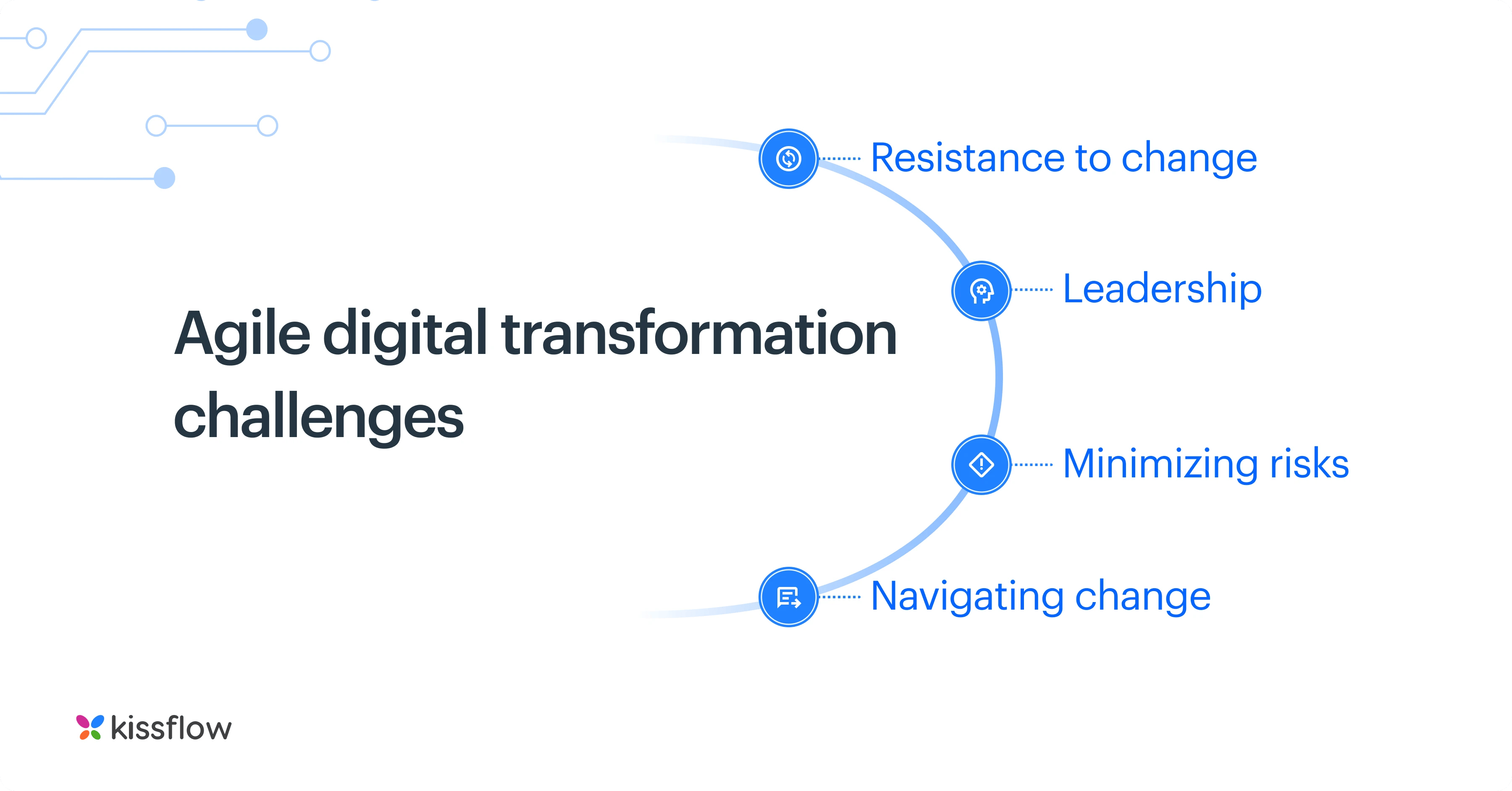
- >
- Digital Transformation >
- How do agile methodologies support digital transformation?
How do agile methodologies support digital transformation?
Team Kissflow
Updated on 19 May 2025 • 8 min read
Since it was created in the early 2000s, agile has become one of the most popular methodologies companies use to organize their software development life cycle or manage projects.
More recently, this approach has found application in managing digital initiatives in organizations looking to achieve process, organizational, and model transformation by leveraging advanced technologies.
CIOs have evolved into key players in driving agility and fostering innovation. They comprehend that in the digital era, leveraging methodologies such as agile is not merely an option—it's a strategic necessity.
So how an agile approach supports digital transformation?
For modern companies aiming to digitize to stay relevant and improve their competitiveness, one of the first things to know is that digital transformation does not happen "once and for all." Instead, it happens through continuous innovation taken in measured steps. Since this basic principle aligns with the agile methodology, following an agile approach to digital transformation promises better results when leaping to level up digitally.
What is agile digital transformation?
The agile approach to digital transformation involves breaking your digital transformation initiative into shorter iterations with a test-and-learn process for each phase. This approach considers possible needs and goals changes throughout the transformation process. Agile digital transformation prioritizes these changes as required instead of following a strict plan or template from start to finish.
Agile digital transformation allows you to gradually launch digital initiatives that change business user processes or models in measurable steps. This approach prioritizes progress at each phase over perfection.
Agile transformation takes a launch, learn and relaunch approach to managing digital initiatives. This allows you to react to market conditions swiftly or customer needs through their feedback. Organizations can improve and relaunch upgraded digital products with the lessons derived from the initial sprints.
Why should digital transformation initiatives begin with agile?
In today's business landscape, digital transformation is necessary for any business that wants to continue to survive. Yet, automating tasks, driving productivity, and meeting customer expectations are more complex than it sounds. Many organizations going through a digital transformation project struggle with it because of the many challenges that come with it.
Research indicates that businesses that adopt the agile methodology experience a 98 percent rate of success and 60 percent more profit than companies that lean towards the traditional approach.
Digital transformation requires adopting advanced software that is often complex without comprehensive training. Employees have to learn to manage new tools and change processes. Decision-makers also have to work through budget restrictions and drive adoption while adapting to changes in customer needs. Considering all of these, it makes sense to adopt a simple but effective management strategy for digital transformation, which the agile methodology offers.
Adopting an agile approach early in your digital transformation project is the ideal solution for navigating these challenges. This method provides enough wiggle room to change business processes while also adapting radically to evolving requirements.
This methodology breaks your entire digital transformation process into short, manageable phases right from the onset. As a result, the team can learn from the result of each stage, adjust where necessary and realign towards set goals before moving on to the next stage.
Core principles of agile digital transformation
The basic foundation of an agile approach to managing digital initiatives is the need for incremental development. Agile is primarily a "grow as you learn" mentality that structures projects in a way that allows teams to learn from errors and make improvements. Agile teams are cross-functional and self-organizing, and the approach favors quality output over merely following rules. Merging these fundamental principles with a digital transformation plan has many implications. The following are some of the core principles of an agile digital transformation model.
1. Formulate a transformative vision
Agile takes a measured but highly structured approach to digital transformation, which is only possible when a clear vision is followed. Digital transformation is all about commitment to innovation, and such a plan can only be successful when it is fully woven into your company's fabric. Organizations adopting an agile digital transformation initiative must do so based on a compelling digitalization vision that employees share at all levels. True transformation is all about creating something big enough to delight your customers.
2. Prioritize the development of digital customer engagement
With digitization initiatives organized with a top-down approach, teams follow the rules, principles, and deadlines to execute digital initiatives. Agile digital transformation ditches rules and processes for people and their needs. Agile digital transformation puts the customer first over everything else. This approach prioritizes finding out the customers' needs with the goal of delivering just what they need at every stage of the initiative.
3. Provide safe digital platforms
The agile approach prioritizes the need to keep innovation secure. It focuses on a modular selection of tools and systems, resulting in greater adaptability, lower costs, and security. To ensure this, agile teams must include security experts that champion the prioritization of security issues on your journey towards transforming your business digitally.
4. Take advantage of digital agility
In agile, large-scale digital initiatives are broken down into time-bound sprints with clear objectives. The "digital agility advantage" is that it allows you to adjust routinely based on shifting market conditions or changing operational needs. This approach keeps everyone on the team informed about the objective of each sprint. Eventually, your digital initiatives move on to the next phase after all the sprint objectives are accomplished. Due to its effectiveness, digital agility allows businesses to test, learn, and improve their digital strategies.
5. Adopt insights with digital data
Agile helps you leverage the data's power within your organization's digital transformation plan. The most advanced digital companies continuously collect data and link and visualize it in a way that yields actionable insights. Agile digital transformation is always data-driven. For effectiveness, a robust data collection and analytics system is built into your digital transformation plan. This allows you to use generated data to make better decisions at every stage.
Benefits of adopting the agile method to digital transformation
One of the primary reasons why the agile approach has gained some mainstream popularity among organizations is because it is a favorable concept that revolves around flexibility, collaboration, cooperation, and communication.
Businesses that adopt the agile method experience a 98 percent success rate and a 60 percent increase in profits as opposed to companies still immersed within traditional methodologies. The agile framework is advantageous for adaptability approaches in work culture and unparalleled focus towards goal attainment. This will also accelerate enterprise It transformation.
Whenever an organization embraces the concept of agile transformation, some of the benefits you can expect include the following:
Better team interaction and communication
In the business world, progress is only achieved with collaboration, especially when the goal is digital transformation. One of the most significant benefits of using agile is that it boosts collaboration through interaction. The agile framework is highly team dependent.
Focus groups, meetings, and sprint review sessions are crucial to any agile transformation initiative. Teams can share their work and ask for opinions and general feedback. Sprint burndown charts help showcase accomplished work and what is left to achieve. Frameworks like these available within agile do not just boost interaction but also the organizational abilities of the company.
Promotes an adaptive approach to digital transformation
The business world operates in modern times because companies are either compelled to digitize or slowly become extinct. While it is not easy for traditional businesses to transform, agile helps them learn and cope subtly. Workers can gain familiarity with complicated software and in-demand IT skills on their schedules. This has established agile as one of the best and most convenient change management methods for digital transformation.
Client-centric
A primary characteristic of agile is that it boosts continuous development and adds value to businesses by being client-centric in an all-encompassing way. This is crucial because clients are the lifeblood of any business and are critical to profit maximization - the purpose behind every business.
A client-centric attitude toward managing digital transformation translates into business success. In several industries, many movers and shakers from the past have been dethroned in modern times by companies that became committed to innovative practices that revolved around customer orientation.
Learn more about Why digital transformation is important?
Agile digital transformation challenges

Despite recognizing the advantages of digital transformation and aiming to achieve it, many organizations fail. It's a complex venture with multifaceted challenges, many of which agile can help you fix.
Some of the challenges of digital transformation that you can improve by adopting the agile route include the following:
Resistance to change
It is common to find employees resistant to change because they fear that the unstoppable growth of technology will eventually replace them. Others do not embrace change because they are used to specific modes of operation which they do not want to see transformed. It is often tough to change how people think and operate, especially when they have had a solidly rooted work culture for years.
A 2016 study [1] on computers and human behavior revealed that human perceptions regarding change are a major issue affecting organizations trying to transition into a digitized work culture. Resisting change can also come from avoiding responsibility and wanting to maintain a dependent culture. One of the dynamic powers of agile is that it empowers employees to take full responsibility for their work. It is also gradual and systematic, which means change is not forced or rushed. Agile teams are self-determined, and there's considerable focus on setting clear goals and visions that can be adjusted based on feedback from stakeholders.
Leadership
Getting buy-in from top-level executives is one of the biggest barriers facing digital transformation in many organizations. With collaboration and communication, getting the right stakeholders' trust and buy-in is easy. The agile approach ensures that everyone knows how a project is going. With progress charts, daily updates, and other tangible ways of tracking progress, getting support for your digital initiatives will be more manageable.
Minimizing risks
Digital transformation is cost-intensive. In fact, many organizations stick to legacy systems instead of digitizing because they’re worried about costs. On top of that, there are no guarantees of success. Many digital initiatives either fail outrightly or miss the mark on specific expectations. Agile digital transformation reduces the chances of failure in any digital initiative. Breaking projects into sprints instead of trying to do them all at once ensures that you’re taking measured steps and that every possible issue is captured and addressed early on. This way, you’re not piling up risks until it is too late.
Navigating change
Agile helps you handle change through continuous improvement. With the traditional approach to digital transformation, adapting to changes in customer needs and market conditions can be challenging. With agile, teams constantly learn and adjust as they move from one iteration of your initiative to the next. Everyone is willing to take feedback and adjust accordingly at each stage before moving forward to the next. This is one of the hallmarks of agile transformation.
Agile digital transformation roadmap
You'll likely find the agile model easier if you follow a standard roadmap. Thankfully, there are standard steps to follow in adopting agile digital transformation.
The agile transformation roadmap is highlighted below:
Preparation
This is the stage where the organization readies itself to use an agile approach to handle the digital transformation. It includes getting buy-in, organizing teams, proposing their values, and defining the objectives of your initiative.
Scanning
This stage requires horizon-scanning techniques to determine the right technologies for digital transformation to help the organization achieve its digital objectives. This technique involves scanning for signs of potential changes and spotting trends before they emerge. This way, you can proactively take steps to achieve desirable outcomes.
Prioritization
At this stage, the company decides on the technologies and valuable resources that can help maximize results. This includes determining and analyzing your solution's most crucial features that ensure it provides value to the users.
Learning
This is the stage where each team member learns about the digital tools and technologies necessary and how to use them to achieve the company’s objectives.
Experimentation
In this phase, the team creates a pilot model or proof of concept to get more buy-in and iron out the kinks of the digital transformation plan.
Planning
At this stage, the agile team creates a plan that helps them introduce this digital innovation to other company employees. The plan includes training them to use the innovation (tool/technology), launch the innovation, and fine-tune it to fit the company and employees' needs.
Building
This is the final stage to adopting an agile model. Here the team builds the tool and uses it to automate the company’s processes.
This agile-driven process is broken down into different time-boxed stages, each stage having its goal. Before proceeding to the next stage, the stakeholders analyze the result of each stage, drawing valuable lessons from them.
Learn more: What are the 4 stages of Digital Transformation?
Conclusion
Several organizations presently benefit from successfully adopting agile digital transformation platform. Agile organizations have teams that are equipped with the structure, tools, and leadership required to drive innovation. They do this by leveraging a customer-centric approach, focusing on collaboration, targeting the right metrics, and being flexible enough to maximize performance.
An agile approach to digital transformation also prioritizes learning, reviews what isn’t working, and focuses on what can be improved throughout the iterations of your digital initiatives. An agile approach to digital transformation helps you grow as you change. Ultimately, this is the best way to achieve true transformation, no matter the size of your organization. Get started with the Kissflow Platform and learn how to leverage its features to drive better results
Wanna Know how Kissflow Can Accelerate Your Digital Transformation?
-Apr-08-2024-06-34-59-2050-AM.webp)
Evaluate your company's digital maturity
✅ Get a clear understanding of where your organization stands
✅ Uncover gaps in your digital strategy
✅ Develop a well-defined digital roadmap
Related Articles













